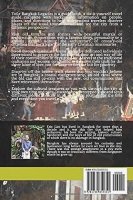| Back to Back Issues Page |
 |
|
Bangkok Travelbug September 2019 Ban Rai Attractions Uthai Thani September 25, 2019 |
| Hello
We were on the mountainous rural road 3011 looking for the hill tribe cultural centre. When we passed Ban I Mat I Sai School, the community school, we knew we were on the right track. About two km further on, we came across a cluster of thatched huts. The two signboards indicated the museum and cultural centre of the Karen Po tribe, this was the place alright. 
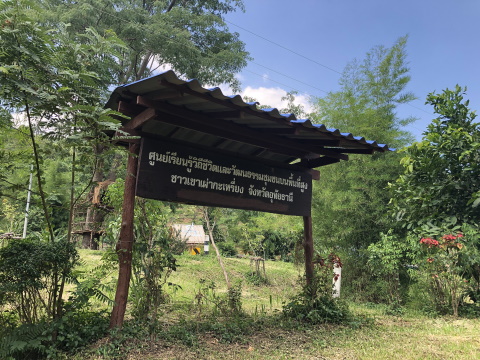
Museum of the Karen Po tribe The museum displayed some farming tools and woven fabrics. A series of display boards provided information on the history, customs and way of life of the Karen Po. But there wasn't a soul around. 
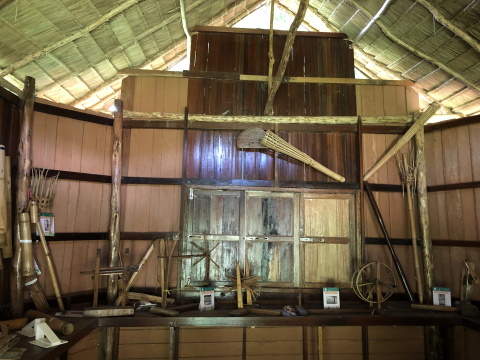
Inside the museum 
One of the display boards relating the short history of the Karen Po A man driving a pickup passed by and told us that it was only in the cool season at the end of the year when there were activities like displays of woven fabrics and other handicraft for sale. We were smack in the middle of the hot season and there was little activity. The Karen Po live in Chiang Rai, Chiang Mai, Mae Hon Son, Lamphun, Lampang, Uthai Thani, Kanchanaburi, Petchaburi and Prachuab Khiri Khan. They settled in Uthai Thani early in the 14th C in the Ayutthaya era. Initially they lived in Uthai Thani City by the Sakae Krang River. Later they migrated to the western region of Uthai Thani in Ban Rai District. There wasn't very much more here but still it's a beautiful place for its greenery and serenity. 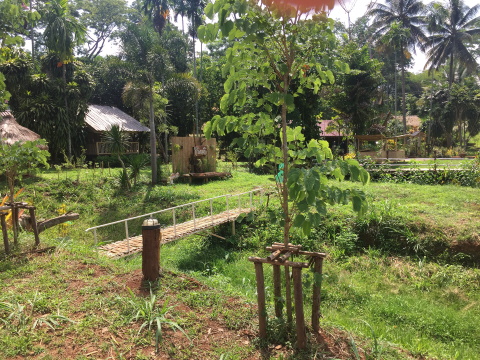
The surrounding area Contents Giant Tree We had better luck at our next stop, the Giant Tree. This tree is a popular tourist attraction in Ban Rai and rightly so. On 28 July 2017 on the occasion of the 65th birthday of HM King Rama X, the Ministry of Culture embarked on a program to select 65 big trees from various parts of Thailand. This program was meant to symbolise the heritage of nature in the Land of Abundance. One such tree selected was located in Ban Sanam, Ban Rai, Uthai Thani. This tree is called ton liang phueng or ton siang in Thai. I'm afraid I can't find the English equivalent. 
The Giant Tree To the locals, it's just called the Giant Tree. It stands at 53m! That's almost an 18-storey building! Its perimeter is more 26m and it would require 40 men to link arms to get surround it completely. This tree is believed to be more than 200 years old. 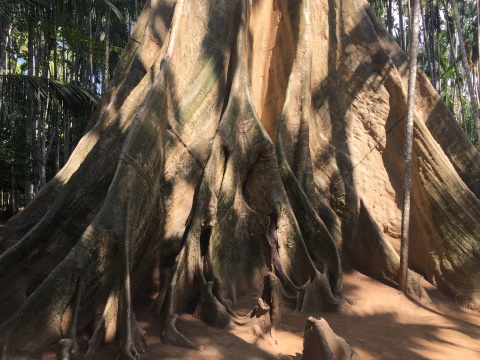
The huge base of the tree created by the roots The Giant Tree stands in a forest of betel palms which also grow to a great height. Locally, the area is known as the Forest of a Million Betel Palms. 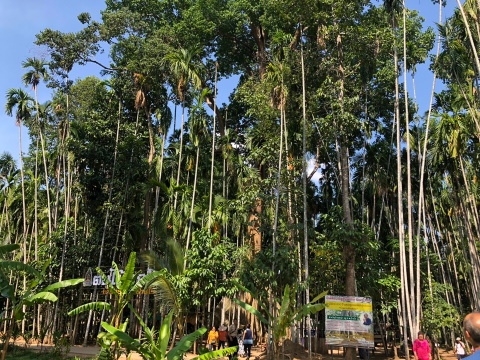
The forest of betel palms There is a market during the weekends to cater for the increased number of visitors. 
The weekend market But the centre of attraction is still the Giant Tree which holds the attention of all the visitors. 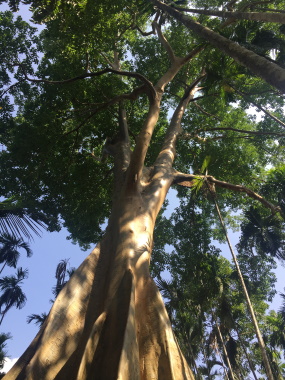
Reaching up to 53 m The residents in the community of Ban Sanam are ethnic Lao from Vientiane. On the night of the new moon in the 6th Lunar month (around the 3rd week of May), they gather at the spirit house next to the Giant Tree to pray in gratitude and to pay respect to the spirits of their ancestors. 
Annual ceremony at the Giant Tree This is a very old custom which has been practised since their forefathers first arrived in Thailand from Vientiane. Contents Wat Tham Khao Wong Wat Tham Khao Wong is a relatively new temple compared to most temples in Thailand, it was built in 1987. The temple is located in beautiful natural surroundings, at the foot of a limestone mountain (khao) which has several caves (tham). 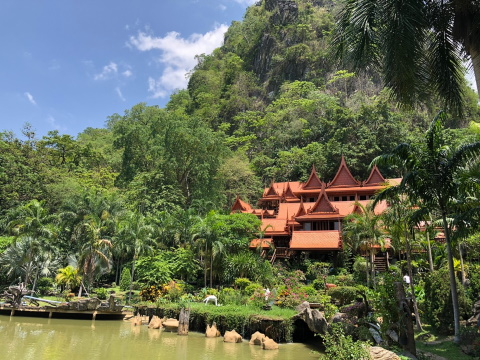
Wat Tham Khao Wong The main attraction in Wat Tham Khao Wong is a four-story sala kanprian (multi-purpose hall) made of teak and built in the side of the mountain, overlooking a huge lake and beautiful garden. 
The sala kanprian 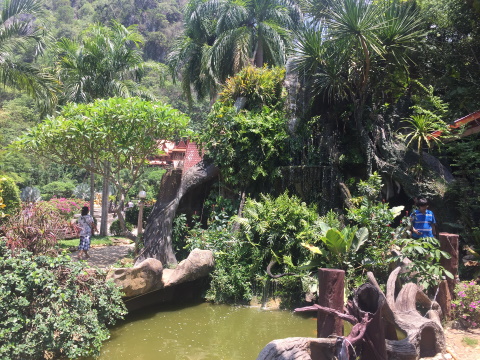


Lake on the way to the sala kanprian On the way to the sala kanprian we passed a temple building, I think it is the ubosot or ordination hall, within a cave! 
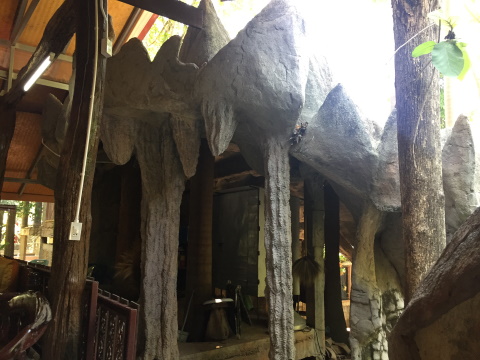
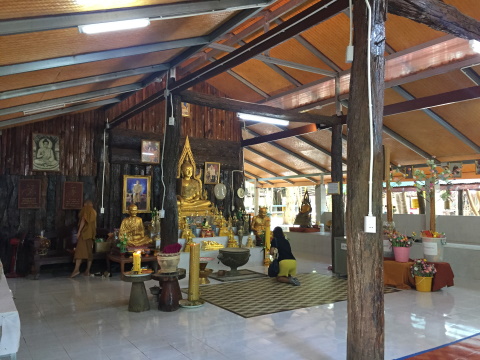
The altar in a cave Take a walk up the sala kanprian to have a commanding view of this scenic area. 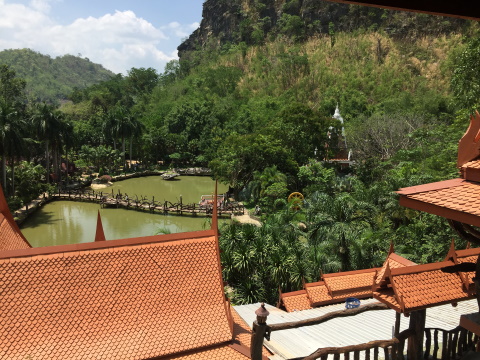
View of the area from the sala kanprian A rocky flight of steps leads up to the mountain behind the sala kanprian. The path up is very rocky and you will need a good pair of walking shoes We passed some caves along the way but didn't venture to enter them as they were too dark and low. The path has a steep rock face on one side and lush forest below. 
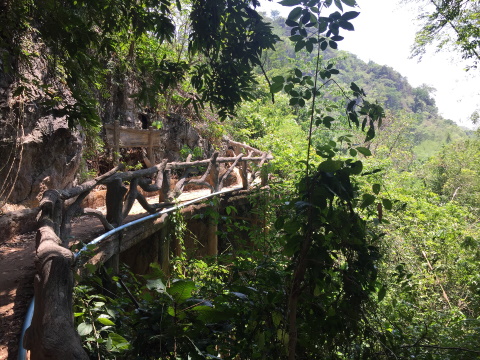
The path up the mountain We finally reached a very steep rocky slope; I think this is the way up to the caves. But after walking up to Hup Pa Tat earlier that morning, we decided to call it a day. 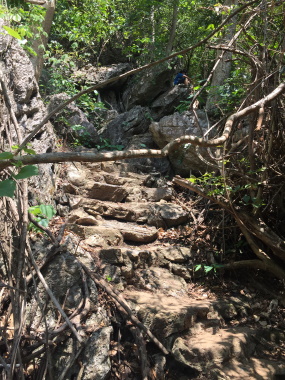
End of the road for us After that vigorous walk, take a break in the restaurant below. It's designed like a temple building and if it weren't for the sign, one might mistake it for part of the temple. 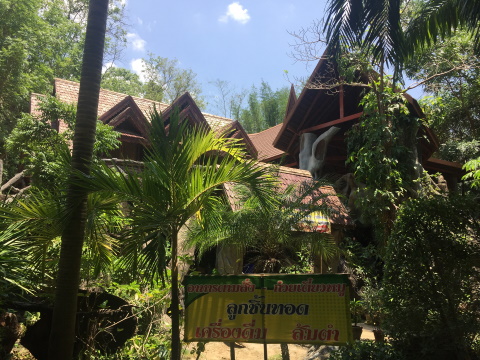
Refreshments Wat Tham Khao Wong is one of the most beautiful temples I have visited in Thailand. It's such a joy walking through the grounds. Contents Ban Tup Luang Weaving Centre We didn't plan on visiting this shop, but it was along the way to Ban Na Ta Po. We were glad we did. This shop is the retail outlet for the Ban Tup Luang Weaving Community and has a wide range of colourful woven fabrics on sale. 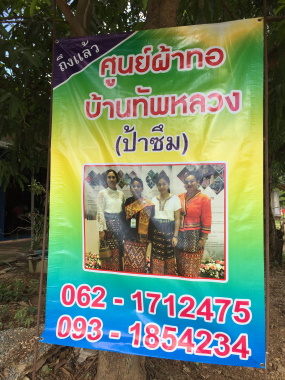
The Ban Tup Luang Weaving Community What's more the lady owner gave us the phone number of Ban Na Ta Po and directions on how to get there. Though the shop has a very humble front, its products are beautiful. 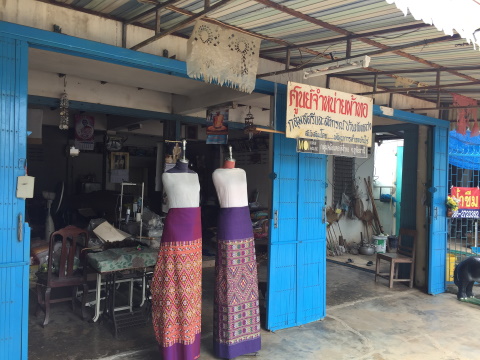
The shop front Here is a sample of the woven fabrics available. 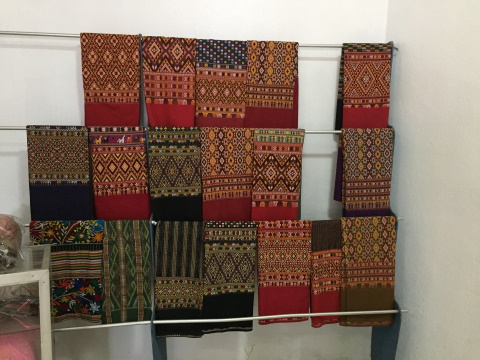


The fabrics on sale Contents Ban Na Ta Po Weaving Centre Ban Na Ta Po was the last stop in our exploration of the attractions in Ban Rai. The journey took us along this deserted country road. 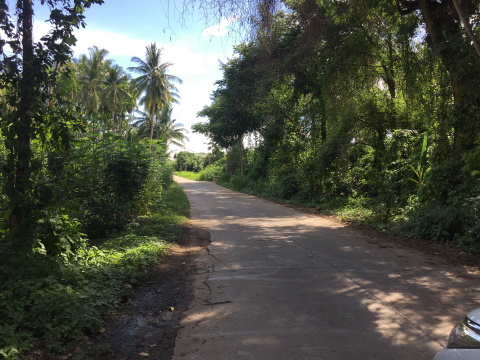
The road to Ban Na Ta Po We turned into a road under an arch with the name of the community on it, which brought us to this signboard. 
Ban Na Ta Po Weaving Community There was a house on the left with weaving looms in front; it turned out to be museum. There were no adults around and the two children helpfully set up some stands to display the cloth exhibits. The rest of the exhibits were mounted on the wall. 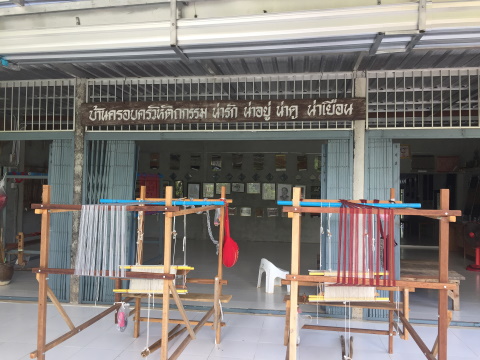
Ban Pa Jam Pi The house museum Ban Pa Jam Pi (Home of Aunt Jam Pi) displayed some exquisite fabrics. 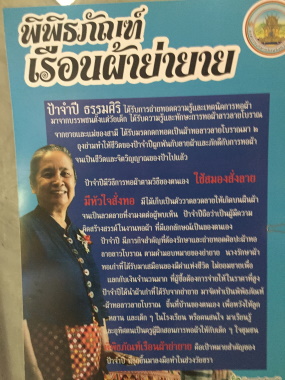
Pa Jam Pi (Aunt Jam Pi) Here are samples of some of the fabrics displayed. 

Displays at Ban Pa Jam Pi Further down the road, we arrived at the official Ban Na Ta Po Weaving Centre set up with the support of the Department of Industrial Promotion to promote handicraft industries in small communities. The owner lived in a traditional Thai house, with several weaving looms in the space below the house. A separate single-story building behind the traditional house served as a display shop and information centre. The land for this building was donated by the house owner to support the community handicraft and local tourism. 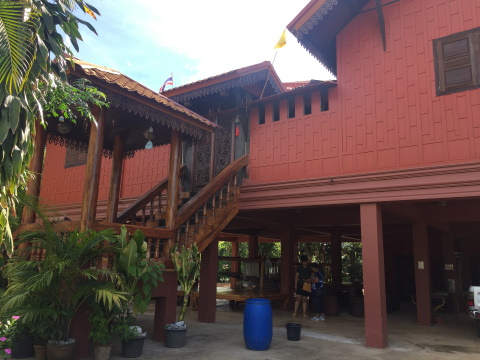
The owner's house It was in the shop and information centre that I learned more about this community. The people here in Tambon Ban Bueng are a branch of the ethnic Lao called Lao Krang. The Lao Krang migrated to Thailand more than three centuries ago, during the Ayutthaya era. Their community handicraft is the weaving of cotton fabric. The word "krang" is the name of the natural dye they use for dyeing the fabric. The traditional Lao Krang long skirt is worn by ladies for religious ceremonies and festivities. The skirt consists of three parts; the top, the main body and the border which is usually dyed red. The skirt is woven in intricate patterns with skills passed down through the generations. 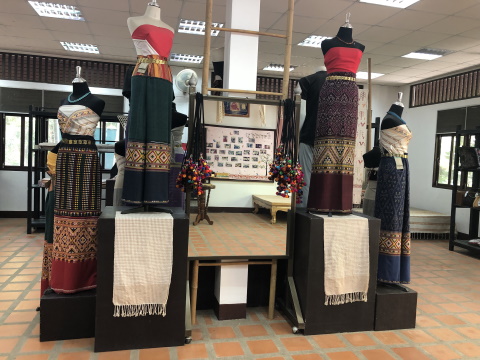


Traditional skirts on display Besides skirts, the shop sells cushions, handbags, pillows and back rests. 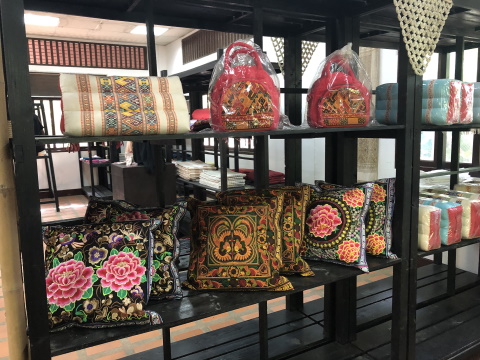
Other items on sale That brings us to an end of our exploration of cultural and natural attractions in Ban Rai, Uthai Thani. Contents Our thanks It was with a tinge of sadness when we left Uthai Thani for the second time. It remains one of the most beautiful provinces we have visited in terms of its natural resources and cultural attractions. We wish to express our appreciation to all the residents of Ban Rai for their helpfulness during our visit. In particularly we are grateful to the members of the Ban Tup Luang and Ban Na Ta Po Communities for their hospitality and for an insight into the fabric weaving of the La Krang. Thank you very much and all the very best in their endeavours. 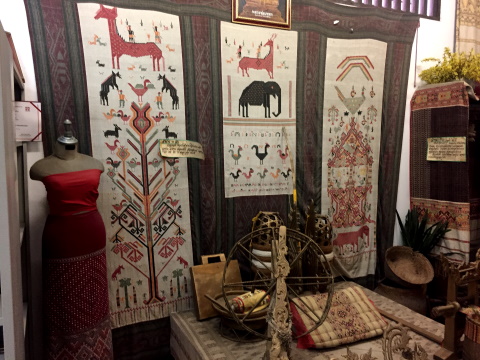
Memories of Ban Na Ta Po Contents Map of Ban Rai Attractions If the map doesn’t appear, click on this link How to get there From Uthai Thani City take route 333 westwards past Nong Chang. Continue south-westwards on route 333 then branch off to route 3011. All the attractions along route 3011 except the Ban Na Ta Po Weaving Centre, the Giant Tree and Wat Tham Khao Wong. To get to Ban Na Ta Po, go to the Ban Na Fai Bueng Ta Po School. At the school turn left and follow the road till you get to the road with the arch indicating Ban Na Ta Po. For Wat Tham Khao Wong, turn into route 4008 and follow it till you get to the temple. The Giant Tree however is easy to locate; there are lots of signboards showing the way. Opening hours 08:00 am – 04:00 pm Admission Admission to all these places is free Have a safe and enjoyable trip! See you next month. Contents Next month Nakhon Sawan – the source of the Chao Phraya River If you enjoyed reading this e-zine, please forward it to a friend. If you received this from a friend and found it interesting, please subscribe at Bangkok Travelbug. What do you think of the Bangkok Travelbug? We love to hear from you What other subscribers have said Till next month then. Eric Lim Tour Bangkok Legacies Find us on Facebook Tour Bangkok Legacies - Kindle paperback edition For those who prefer reading printed books rather than e-books, here's the paperback edition of Tour Bangkok Legacies, which will help you along as you explore the streets of Bangkok and discover its old treasures. It's complete with historical descriptions and directions on how to get to these places. My Kindle paperback edition 
Copyright@2008-2019 Tour Bangkok Legacies All rights reserved |
| Back to Back Issues Page |

